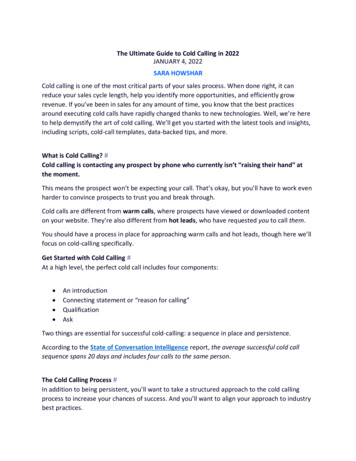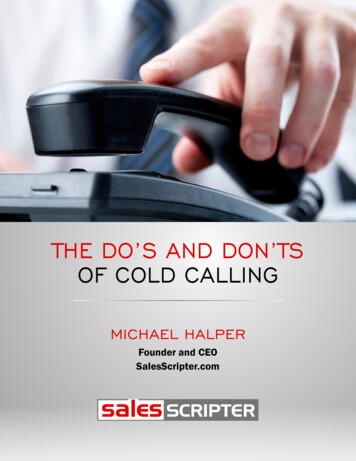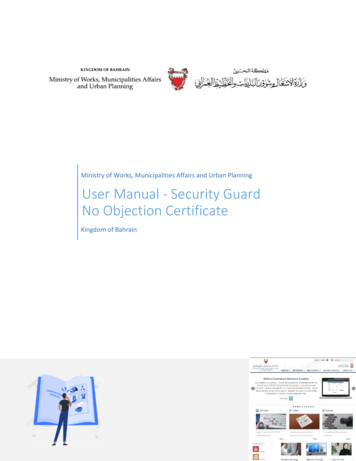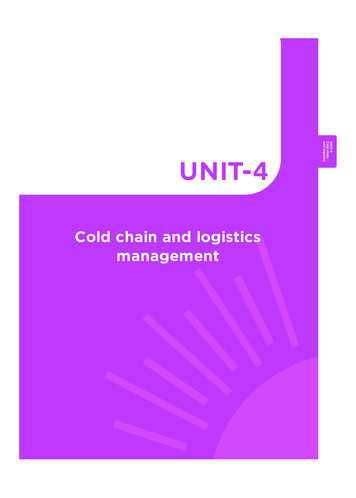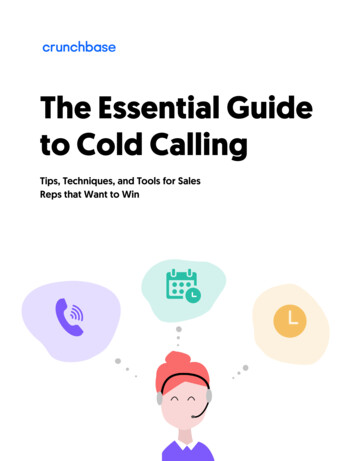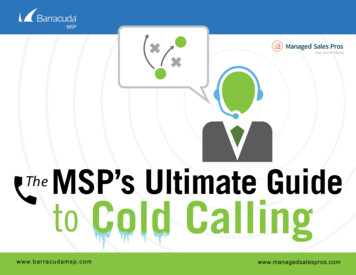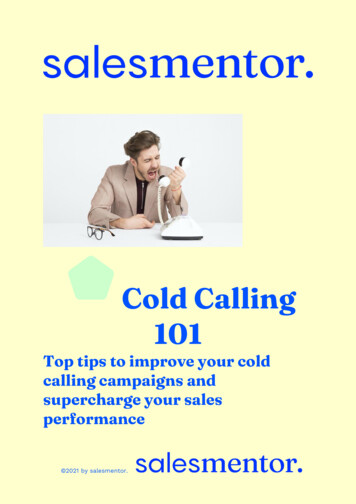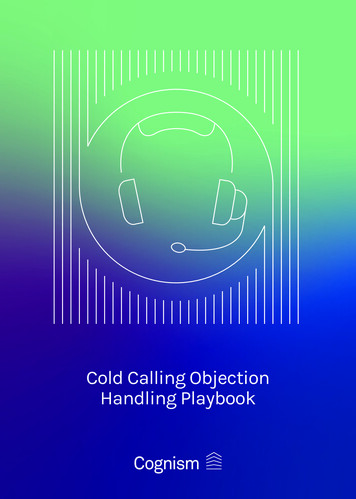
Transcription
Cold Calling ObjectionHandling Playbook
ContentsIntroduction 3What are objections? 4What is objection handling? 4Why is objection handling important?4Cognism’s five-point plan for cold callobjection handling 5Four common B2B sales objections and how to handle them 7Conclusion 10
IntroductionIf you’re a sales rep working in B2B, and you’re making cold calls every day,then you’ll know that getting objections from your prospects is inevitable.Almost every prospect you talk to will have objections of some sort.If you’re a sales repworking in B2B, and you’remaking cold calls everyday, then you’ll knowthat getting objectionsfrom your prospects isinevitable.All B2B salespeople have to learn how to handle objections during theircold calls - which is why Cognism is offering this free guide to cold callingobjection handling.We’ve spoken to some of Cognism’s star salespeople, who helped us togrow exponentially over the last 12 months (a 657% growth in revenue in2018). They are experts in cold call objection handling and they’ve sharedtheir five-point plan for dealing with objections. We’ll also take a look atthe top four most common objections that Cognism Sales has faced ontheir cold calls - and how to resolve them. Let’s get started!Cold Calling Objection Handling Playbook3
What are objections?An objection is whena prospect raises aconcern about theproduct or servicethe salespersonis selling.Objection handling isthe process wherebya sales rep answersand works toalleviate a prospect’sconcerns.Being able to handleobjections effectivelycan determinewhether a deal is wonor lost.An objection is when a prospect raises a concern about the product orservice the salesperson is selling. They can be about anything, but someof the most frequent objections you’ll encounter will be around price, needand timing.One important point that salespeople often forget is that objectionsaren’t a sign that the prospect isn’t interested. Quite the opposite, infact - they’re an indicator that the prospect is interested, but doesn’t yethave a full understanding of your product or service. It’s your job as asalesperson to give them that understanding.WHAT IS OBJECTION HANDLING?Objection handling is the process whereby a sales rep answers andworks to alleviate a prospect’s concerns. It’s about filling in the gaps intheir knowledge and guiding them to a position where they’re ready topurchase.Remember that most objections are entirely valid. You can’t just brushthem off. You have to provide insight and give the prospect a compellingreason to buy from you.WHY IS OBJECTION HANDLING IMPORTANT?Being able to handle objections effectively can determine whether a dealis won or lost.Always address objections on your cold call as quickly as you can. Thelonger you leave it, the stronger the prospect’s concerns will become - andthe harder it will be for you to change their mind.Cold Calling Objection Handling Playbook4
Cognism’s five-point plan forcold call objection handlingIn B2B sales, preparation makes perfect. This is especially true when itcomes to handling objections, which could come at any time during yourcold call and be about any subject. Don’t improvise and make it hard foryourself. Instead, ensure you have a process in place. Cognism’s salesteam uses the following five-point plan when they face objections on theircold calls. It’s formed the basis of our own objection handling playbook.ListenAskSolveConfirmMove on123451. LISTENIt sounds like an obvious point to make but a lot of sales reps forget to dothis. In their rush to make a sale, they talk more than they listen.The prospect should do70% of the talking, whilethe sales rep should onlydo 30%.This is the wrong approach. The best salespeople are always those wholisten. One rule of communication during a sales call - the 70/30 rule states that the prospect should do 70% of the talking, while the salesrep should only do 30%. What’s the benefit of doing this? The more theprospect feels like they’re being heard and understood, the more likelythey are to buy. Listening to their objections is the first step to making asale more probable.Here’s another useful stat for you: when buyers were asked what theywanted from salespeople, 69% answered: "to listen to my needs." Yourprospects are crying out for it! So stop talking and listen to theirobjections. The more you listen, the more you’ll learn - and the knowledgeyou’ll gain will help you out massively when it’s your turn to respond.2. ASKThe more information yougain from the prospect,the easier it’ll be to handletheir objections.Listening is one thing; letting the prospect know that you understandtheir objections is another. A great way of doing this is to ask qualifyingquestions. It will help to build up trust and rapport with your prospect.We recommend that you always ask open-ended questions (questionsthat don’t require a "yes" or "no" answer). Asking these types of questionswill let the prospect know that you’re interested in what they have to say and it’s also a great method for getting more information out of them. Themore information you gain from the prospect, the easier it’ll be to handletheir objections.Cold Calling Objection Handling Playbook5
3. SOLVEOne good tip from CognismSales is to answer theprospect’s most urgentobjection first.Once you’ve listened and indicated your understanding of the prospect’sobjections, then it’s time to solve them. This step requires some quickand nimble thinking. The best thing to do is to stay calm and think aboutwhat you’ve done in the past. How have you handled objections for other,similar companies? Over time, you will build up a library of solutions youcan deploy whenever they’re needed.One good tip from Cognism Sales is to answer the prospect’s most urgentobjection first. The reason for this is, once you’ve resolved that, it makesanswering all the other, less troublesome objections much easier. You’veshown that you can be trusted and it will make the prospect feel muchmore certain that you have the solutions they’re looking for.4. CONFIRMOne good piece of advicefrom Cognism Sales isto repeat the prospect’swords back to them.In this step, you have to find out if the solution you’ve offered meets theprospect’s requirements. Ask them if they’re happy with what you’vesuggested. If they are - great! You can continue with your cold call. Ifnot, you’ll have to go back and make sure if you’ve fully understood theobjection. Ask some more questions and see if the prospect’s answerspoint at an alternative solution.One good piece of advice from Cognism Sales is to repeat the prospect’swords back to them - for example, if they’ve objected to the pricing, youcan say, "I understand the pricing is higher than you expected." This is aneasy tactic for confirming your understanding of the objection.5. MOVE ONDon’t spend more timeon one objection than isstrictly necessary.When the customer is satisfied with your solution, then you can bothmove on to the next step in the cold call. This could be either facinganother objection or (hopefully!) closing the deal.Don’t spend more time on one objection than is strictly necessary. Listento the objection, ask questions, define it, provide a solution - and thenprogress to the next one. Never go back to an objection once you’veaddressed it.6. BONUS TIP: WHAT IF YOU DON’T HAVE THEANSWER?If the prospect asks you something that you genuinely feel you can’tanswer - don’t blag it! Tell the prospect you’ll have to refer their questionupwards - and always, always agree on a timeframe for you to supply aresponse.Cold Calling Objection Handling Playbook6
Four common B2B sales objections- and how to handle themAt Cognism, we teach our SDRs to qualify leads according to the BANT criteria:BUDGETAUTHORITYNEEDTIMINGIs the lead ableand willing tospend?Is the leadthe ultimatedecision maker?Does the lead havea problem that yourproduct can solve?Is the leadlooking to buyquickly?The most common objections you’ll encounter in B2B sales will be basedaround one of these four areas. We’ve consulted with our sales team andthey’ve selected the four objections they see most often during their coldcalls. Each of the four objections corresponds to a particular part of theBANT criteria. They’ve also supplied the best tactics for dealing with theseobjections. Following their advice can make all the difference between losingand winning a sale!1. BUDGET"I don’t have the money to buy."You have to give theprospect a compellingreason to buy from you.Have some suitable casestudies and testimonials tohand during your cold call.First, find out more about the reasons behind the objection. Is it genuinelythat the price is too high, or is it that the prospect doesn’t see the value ofyour product for the price they’ll have to pay?If it is that the price is too high, emphasise the value of your product orwhat makes you different from the competition. If they don’t see the value,explain how your product will change their life for the better! This couldbe anything from saving them time or money, or helping them to generateleads and revenue. You have to give the prospect a compelling reason tobuy from you.A compelling reason needn’t necessarily be based around pricing or cost.It could be anything from certain product features, the level of customerservice that your company provides, or customer reviews.If the prospect still has an objection, try to avoid the temptation ofgoing straight to discounting. Doing this can all too quickly devalue yourproduct. If the prospect has a pricing objection, there are other thingsyou can suggest instead of taking money off. Perhaps consider bespokepayment terms that help spread the cost of investment, without reducingthe overall price.Another strategy for resolving a pricing issue is to bring up some ofyour company’s success stories. Prove that other organisations areCold Calling Objection Handling Playbook7
achieving results with your platform and that the expenditure is worthit. Mention some satisfied customers who work in the same industry asyour prospect (this is a very important point - whichever customers youmention, they must be relevant to the prospect). Have some suitable casestudies and testimonials to hand during your cold call.2. AUTHORITY"I’ll have to speak to my boss about this before deciding."Maybe you can providesome information that willstop them from referringtheir query upwards.To handle this objection, start by confirming what the prospect’s concernsare. Maybe you can provide some information that will stop them fromreferring their query upwards. If you play this right, you can turn theprospect into a champion for your product. They can help you get the buyin you’ll need from the ultimate decision maker.If that doesn’t work, and a third party has to be involved, immediatelyarrange a time to speak with them.3. NEED"We really don’t need your product right now."Provide the prospect withsome data that displaysthe difference your productcan make.Keep up to date with thecontent your business ispublishing and utilise it inyour objection handling.With this objection, you need to get to the root of the problem. What’sstopping them from buying? It may be that the prospect loves certainproduct features, but not others. It may be that they just can’t see (yet!)how your product will help them.Two things will assist you here: data and content.Provide the prospect with some data that displays the difference yourproduct can make. Always have two to three stats nearby whenever you’recold calling. However, check that the stats you’ve chosen are relevant tothe prospect’s industry or business. There’s no value in sharing salesstatistics with a marketer, for instance, or giving revenue growth datafrom your enterprise clients to a startup!Make use of the materials produced by your marketing team (if youhave one!). Come prepared to the cold call with a couple of appropriatecustomer case studies. If the prospect has a couple of very specificquestions, maybe you can direct them to a blog or two on your companywebsite. Keep up to date with the content your business is publishingand utilise it in your objection handling. Perhaps suggest scheduling in aregular content meeting between sales and marketing, so both teams areproperly aligned.4. TIMING"It’s not the right time for us to buy."How you handle this objection all boils down to the prospect’s reason fordelaying. But whatever their reason is, the most important thing to dois to create a sense of urgency. Remind the prospect of the costs of notbuying your product now.Cold Calling Objection Handling Playbook8
This is where all the research and information you’ve gained during yourcold call will come in handy. Use what you’ve learned to turn the objectionon its head. Here are a few scenarios from Cognism’s sales team to getyou thinking: Maybe the prospect’s company is launching a major newproject or initiative. Can your product help them out at thiscritical phase?Has the prospect’s company recently acquired funding? Showthem how your product is a wise investment and can taketheir business to the next level.Has the prospect only recently joined the company? Tell themyour product can help them to achieve great results and makea big impression early on.Perhaps the prospect’s business had a bad quarter. Is there anopportunity for your product to turn their fortunes around?If the objection is based around an incoming hire withultimate decision-making power, explain to the prospect howyour product will enable them to become even better at theirjob once they arrive.The trick is to turn eachdisadvantage into anadvantage.The trick is to turn each disadvantage into an advantage. The bottomline is - investigate each objection, ask searching questions, uncover thereason behind each one - and then use the information to handle themeffectively.Cold Calling Objection Handling Playbook9
ConclusionBy learning how to handleobjections smartly, you willincrease your chances ofclosing a sale.Knowing how to address objections during a cold call is a key skill thatall B2B salespeople have to master. Especially so if you’re working ina scaling business, which may have limited manpower, resources andtechnology at its disposal. When you’re scaling, you need all the wins thatyou can get!By learning how to handle objections smartly, you will increase yourchances of closing a sale. Hopefully you’ve found this guide useful. Whenyou’ve finished reading it, be sure to get back on the phone and try outsome of Cognism’s winning strategies. Good luck - and keep calling!TAKE ACTIONCognism can supply your B2B sales team with all the data they’ll needto make handling cold call objections even easier. From sales triggersthat tell you when a prospect is most likely to buy, to data enrichmentthat automatically updates out-of-date records in your company CRM Cognism is the number one toolkit for a scaling sales operation.Book your free, 15-minute demo with us now!Request a demoCold Calling Objection Handling Playbook10
Cognism is a sales acceleration platform, using patentedAI technology, to provide B2B sales teams with a blend ofreal-time company, people and event data to streamlineprospecting, find and deliver new revenue.
cold calls - which is why Cognism is offering this free guide to cold calling objection handling. We've spoken to some of Cognism's star salespeople, who helped us to grow exponentially over the last 12 months (a 657% growth in revenue in 2018). They are experts in cold call objection handling and they've shared
